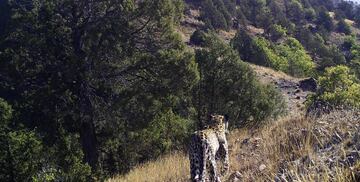Species population numbers “plummet by 69%”, more evidence of Earth’s mass extinction
The World Wildlife Fund has highlighted the data showing that more than two thirds of the wildlife population have dropped since 1970, another warning from nature.

“Nothing is what it seems on the surface,” opens the latest video from the World Wildlife Fund (WWF). “Across countries, across environments, across out planet, our relationship with nature is broken.”
The stark reality of the message becomes clear. On average, the WWF explains, 69% of the world’s wildlife populations -- bird, mammal, fish, reptile and amphibian -- have dropped since 1970. That’s in just half a century! Earlier this year we brought you the news about scientists having estimated that 99% of all living organisms that have ever lived on earth are now extinct. The planet’s natural ecosystem, they said, is constantly evolving and as the environment changes, with our help, certain older species begin to fade away.

Earth’s mass extinction continues
The report that this information is based on, was released on Thursday and points to the decimation of forests and pollution of our oceans as causes of what is being dubbed by many as part of a global extinction event. Unlike Hollywood’s various attempts to suggest this may happen with an alien invasion, dinosaur-equivalent meteor strike or the uprising of the undead, this one is being consciously caused by humans. A lesson in self-harm that will likely be judged harshly by historians of a bleaker future.
The WWF report found that population sizes had decreased by 69% on average, based on Zoological Society of London (ZSL) data from 2018. The main causes of the loss were deforestation, human exploitation, pollution, and climate change. Wildlife populations in Latin America and the Caribbean were particularly hard hit, with a 94% decline in just five decades. One population of pink river dolphins in the Brazilian Amazon, it says, declined by 65% between 1994 and 2016.
The list of endangered species that is tracked by the WWF is a sad reflection on where we are as an international community.
Mark Wright, director of science at the WWF in the United Kingdom couldn’t have put it more bleakly. “Nature was in dire straits, and it still is. The war is unquestionably lost.”
Wildlife population sizes declining at 2.5% annually
According to Andrew Terry, director of conservation and policy at the ZSL, this “significant drop... tells us that nature is unraveling and the natural world is emptying.” The findings, he says, were broadly similar to those in the WWF’s most recent assessment in 2020, with wildlife population sizes continuing to decline at a rate of about 2.5% per year.
For those looking to find some positive news from the report, there was some. While the population of eastern lowland gorillas in the Democratic Republic of the Congo’s Kahuzi-Biega National Park declined by 80% between 1994 and 2019 due to bushmeat hunting, the population of mountain gorillas near Virunga National Park increased from around 400 individuals in 2010 to over 600 by 2018. This, of course, goes against the trend of the widespread declines, a situation that has prompted desperate pleas for increased environmental support.
Delegates from around the world will meet in Montreal in December to develop a new global strategy to protect the world’s plants and animals, with increased funding for global conservation efforts is likely to be one of the most pressing demands.
“We are appealing to rich nations to provide financial assistance to us in order to protect our environment,” said Alice Ruhweza, WWF’s regional director for Africa.
Interpreting the data: pitfalls aplenty
The report referenced above is serious and certainly worth attention. More than that, it demands action. That said, when it comes to analysis and interpreting this volume and complexity of data, care must be taken.
As explained by data experts at Our World in Data, although the Living Planet Index reports an average decline of 69% across tens of thousands of wildlife populations since 1970, ‘it does not tell us anything about the number of individuals, species or populations lost, or even the share of populations that are shrinking.’
They continue by saying that before reporting on it ‘we should understand what it actually tells us about the world’s wildlife,’ and that we have to be ‘aware of the misconceptions and pitfalls of using this index to capture the changes in more than 30,000 of the world’s animal populations.
‘To be clear once again: the LPI does not tell us the number of species, populations or individuals lost; the number of extinctions that have occurred; or even the share of species that are declining. It tells us that between 1970 and 2018, on average, there was a 69% decline in population size across the 31,821 studied populations.’






